Grimtooth's Traps by Asimo
Rube Goldberg Would Be Proud
Original SA post Grimtooth's Traps: Rube Goldberg would be proudTo properly tell the tale of this book, we'll need to go a bit back in time. While Dungeons & Dragons is considered the first true roleplaying game, the actual gaming hobby predates it by quite a while. There were board games, war games (with or without miniatures), card games, even play-by-mail games that basically took the part of modern play-by-post style games over a much longer time scale. In 1970, three years before Tactical Studies Rules was founded, Flying Buffalo games got it's start by... well, I'll just quote wikipedia.
Wikipedia posted:
Founded by Rick Loomis and Steve MacGregor in 1970, the company got its start running a simple computer-moderated wargame, Nuclear Destruction , widely considered to be the first commercial play-by-mail (PBM) game.
If we fast forward a few years to 1980 or so, Flying Buffalo started publishing the "Catalyst" line of system-neutral and statless supplements for "fantasy roleplaying games", such as maps you could use or cities you could easily port to your game of choice by statting up the NPCs and such on your own. To the best of my knowledge they were the first company to do third-party supplements, although several others followed over the years. And not long afterwards in 1981, over thirty years ago now, they first released Grimtooth's Traps.
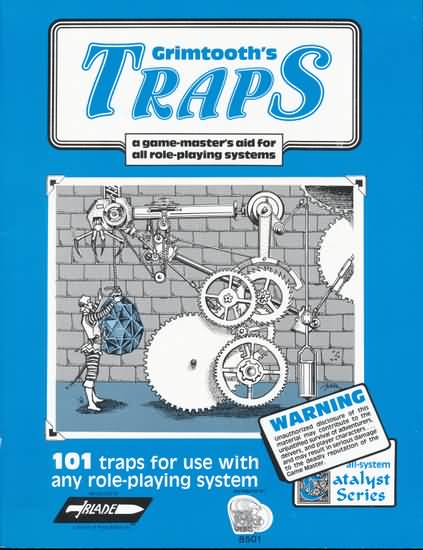
The title is fairly self-descriptive, as it's a book of traps, as presented by the eponymous Grimtooth himself, a troll given a cartoonish representation, and who nominally is describing the traps contained within. Later books in the series introduce other characters, but for now this is all Grimtooth's show.
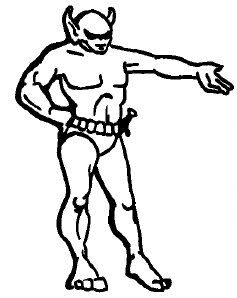
Pretty typical RPG art for the era.
In actuality, the traps were given through suggestions from Flying Buffalo staff and customers, and each one was given proper credit. It opens up with a well intentioned but somewhat quaint note...
Grimtooth's Traps posted:
Attention
The traps in this booklet are designed for game purposes only. Actual construction of these traps might prove harmful, and such construction is strongly discouraged.
Grimtooth posted:
Besides, if you don't like my book, I'll rip your lungs out.

Curiously, despite the fact that the book is obviously aimed towards the "kill them quick" style of dungeonmastering that encourages the checking for secrets and traps every five feet and never touching anything with less than a ten foot pole, none of the traps have game stats attached to them in order to keep the book system-agnostic, and this means the book goes on to explain that you can easily make things harder or easier on the character. Each trap has a "deadliness rating" of one to five skulls that gives a rough estimation of whether or not you'd need a closed-casket ceremony for the unwary
Grimtooth's Traps posted:
By filling a pit with obnoxious-smelling green dye instead of boiling oil, you have essentially altered the entire trap - yet the delivery system remains the same.
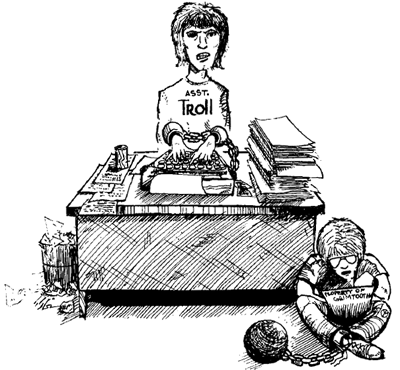
This is not a serious book.
There's not too much else at the start, besides an explanation that the book is broken down into chapters to make it easier to find specific traps; in order, Room Traps , Corridor Traps (itself with several sub-chapters), Door Traps , Items and Artifacts , the leftover miscellany Things , and of course, the decidedly enigmatic 101st Trap . The book's introductory page are fairly short, as the vast majority of the 64-page text is unsurprisingly spent on describing the traps themselves, typically two or three to a page, and many with illustrations. Next time, we'll be starting with at Room Traps. But until then...
Grimtooth posted:
Enjoy it or die, mortal.

Room for More
Original SA post Grimtooth's Traps - Room for moreBefore we get too much farther in your daily dose of trappage, three important things need to be said about how the traps in the book are designed. It's coming from the mindset of a "classic dungeoncrawl" campaign - not surprising considering the book's age and lineage - so there are the unspoken assumptions that:
-
The adventurers are, in fact, greedy thieving bastards and
will
steal everything that isn't nailed down in order to line their pockets with filthy lucre.
-
The adventurers are not, in fact, idiots, and will be using some sensible degree of precaution in their dungeon crawling; searching for traps, taking the safest and most conservative choice, and so on.
- The Dungeon Master is a sadistic and easily amused antagonist who is well aware of the above two facts, just as the players are well aware that the DM is trying to dick them over. Both sides plan and act accordingly.
Grimtooth's Traps posted:
The room trap is probably the most fear type of dungeon doom device. It is the main event, the central attraction, the carefully-planned and patterned engine of destruction geared solely towards the destruction of those who venture within. No mere hallway nuisance or dangerous treasure are these - room traps are thoroughbred delivery systems of dismay, designed only to kill.
 But let's start off with the first trap listed in the book, the
Infamous Wheel Trap
, a four-skull rating trap by Paul O'Connor, the book's editor.
But let's start off with the first trap listed in the book, the
Infamous Wheel Trap
, a four-skull rating trap by Paul O'Connor, the book's editor.
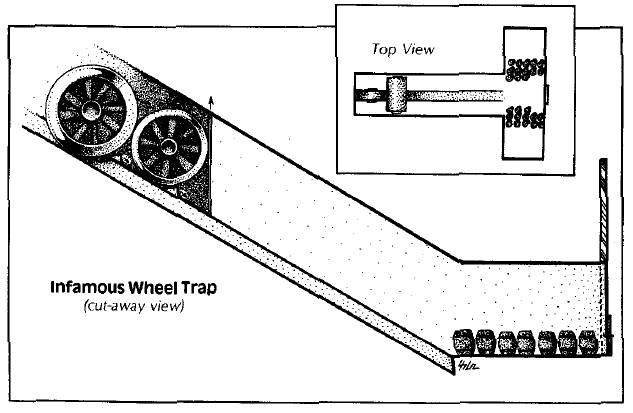
quote:
The trap design is rather complex. The delvers walk through a door to find that they are standing at the base of a long ramp. The incline slopes up away from them, and ends in a wall with a door in it. A 5' trench is dug down the direct center of the incline, and runs from the base of the slope to disappear beneath the door. The ceiling over the main-corridor part of this trap is quite high.
To the right and left of the delvers, as they stand at the base of the incline, are two small, featureless rooms. Entrance to these rooms is blocked by several rows of sealed barrels, arranged so as to stand partially into the main corridor. Upon inspection, these barrels will prove to be filled with a liquid of some sort (determined by the sloshing sound when they are nudged) - but the containers will also prove to be both unopenable and completely immobile. Delvers will find with a bit of effort that they can scurry over the tops of these barrels and into the rooms beyond.
quote:
The trap is activated when a member of the party actively starts up the slope. At this time, a steel curtain will slide down from the ceiling to block the doorway through which the delvers entered. At the same moment, the large wall up the corridor will drop into the floor, revealing a large, black, corridor-sized wheel. No longer restrained, the wheel begins to roll down the slope, towards the party, at an amazing speed!
 But it's a pretty direct peril, so maybe there's some way around it, like destroying the whee-
But it's a pretty direct peril, so maybe there's some way around it, like destroying the whee-
quote:
The wheel reeks of strong anti-magic, and is indestructible.
quote:
The large wheel will pass over the characters in the trench (unless they're giants, or something equally absurd) - but those characters will be horrified to see that there's a second wheel, every bit as deadly as the first, rolling down the trench just a few feet behind the first wheel. The only way to escape the wheel is to leap back out of the trench - something that should prove considerably tougher than simply jumping in.
The characters that escaped the wheel(s) by rushing into the side rooms aren't out of the woods yet, either. The barrels of liquid mentioned before (...) will collapse scientifically, slowing the wheel just enough so that it will still crush any character caught behind it, but won't do any major structural damage. The barrels however aren't filled with water or foam - they've been filled with a burning, corrosive acid! The acid will spray into the side rooms, almost certainly covering the characters standing within.
 Just in case this (I remind, only 4 of 5 skull trap) isn't tense enough, advice is given to make any rolls involved during the wheel's initial descent "tougher and tougher" in order to encourage quick (poor) decision-making, with the chance of a failing character blocking a particular escape path. Fortunately, some advice is also given in case the adventurers did somehow survive in order to let them continue, such as the splashing acid perhaps revealing a secret door..! ... Yeah.
Just in case this (I remind, only 4 of 5 skull trap) isn't tense enough, advice is given to make any rolls involved during the wheel's initial descent "tougher and tougher" in order to encourage quick (poor) decision-making, with the chance of a failing character blocking a particular escape path. Fortunately, some advice is also given in case the adventurers did somehow survive in order to let them continue, such as the splashing acid perhaps revealing a secret door..! ... Yeah.
Still! We're off to a good start. So why not move onto the next trap? The Lobster Trap , another four-skull one from Paul. This one requires a bit of setup, as it's less a trap the heroes stumble upon and instead a deathtrap a merciful(?) gamemaster puts unconscious player characters into. At least this is quite plausible, as dungeon crawling goes.
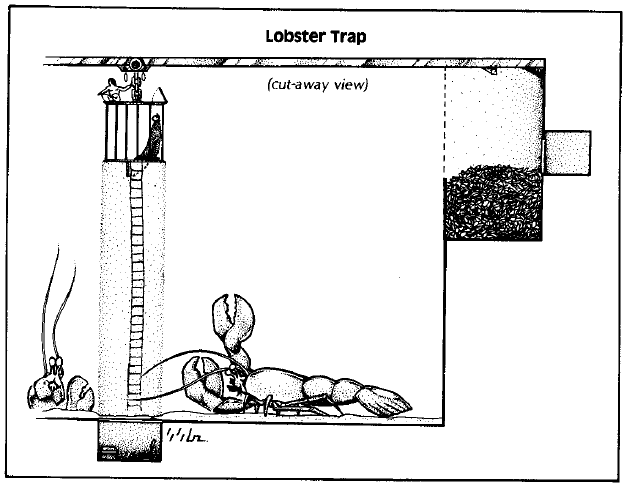
quote:
The delvers are being held captive in a cage suspended fifty feet above the sandy floor of a large, circular room. Hungry rock lobsters prowl the room, menacingly clacking their claws in anticipation of the feast to come.
 Well, it's as threatening as anything else. Presumably one could change the critters out for some other horrible beast of preference, at least.
Well, it's as threatening as anything else. Presumably one could change the critters out for some other horrible beast of preference, at least.
quote:
The cage itself hangs from a winch. The winch is fixed into a track that runs across the room's ceiling to terminate in a black wall some distance away. The cage itself has two trap doors, both easily visible and unlocked. The trap door opens onto the roof of the cage. Characters can move freely about on the cage roof, where they'll note that the winch device is equipped with two ring-like handholds.
There is more to this situation than meets the eye. First, the cage projects an undetectable invisible-wall spell from the cage's bottom all the way to the floor. This will allow the characters to climb down the rope ladder safely, as the lobsters cannot breach the wall - but don't tell the delvers that! Second, the wall section in which the ceiling track terminates is, in reality, a thin section of painted parchment - the track continues straight on through. Finally, a hidden hollow in the floor below the cage's original position contains a treasure chest and an unmarked lever set into the ground.
quote:
A single character must crawl on top of the cage and pull on the handhold rings with all his might. This will drain from the character some predetermined amount of strength, causing the cage to slide along the track in the ceiling and then drop. If the character is strong enough to fulfill the winch's requirements, then the cage will move through the false wall section to fall into the bed of feathers beyond. If the character in question lacks the required strength, then the cage will move a considerably shorter distance before falling - this time down to the lobsters below. Too bad.
quote:
The hollow contains a chest full of treasure. (...) Beside the chest is a lever,t he function of which is indiscernible. Levers lead doom for dungeon delvers. Pulling the lever immediately, irrevocably, cancels the invisible-wall spell projected by the cage. The lobsters, being sensitive to such things, will rush in greedily for the kill.
quote:
As previously noted, the character's possessions await them in the room just beyond the chamber full of feathers. If you feel really mean, booby-trap them.

Well, let's do something slightly safer, right? A three-skull trap. Middle of the pack here! The One that Got Away , by a Michael Austin. This one is probably perfectly plausible, and-
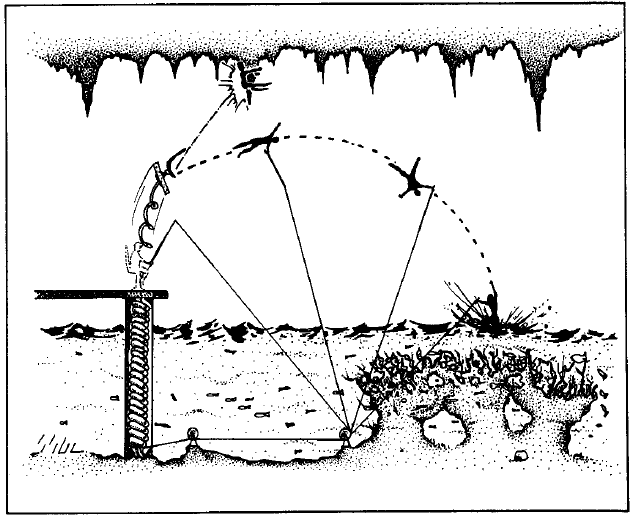
...

I'm not going to bother with quote snippets here, as it's fairly self-explanatory... as such traps go. There is an underground lake, with a pier complete with fisherman's chair and pole. The adventurer decides to go angling for some reason, and as soon as the line goes taut, the spring under the chair fires. Sending the poor hero into the jagged stalactites, the jagged shallow reef hidden in the murky waters, or just left for the maneating fish in the lake. Simple and horribly (in)efficient! Even the book admits outright that "this trap goes to such incredibly lengths to be silly". But who knows, maybe there's gold in the water or something to attract the adventurer's attention?
As noted in the first post, I'm not going to go into detail on every trap here. But what hasn't been elaborated on? The Roman Amphiteatre , Illusions , the Slider Spiker , The Deluxe Centerpost , The Dastardly Lava Room , the Hoovermatic Trap , The Bigger They Are , The Atlas Affair , The Bridge at Rue Vincent , and Is it the Piccolo, or Is it Memorex? , which gets special mention for including shoggoths as a central feature.
And next time... Corridor Traps !

All in a Row
Original SA post Grimtooth's Traps - All in a rowGrimtooth's Traps posted:
A long, dark, damp dungeon corridor is probably the most common setting for a trap. Ceilings can fall in, walls can drop down, arrows can fly from hidden ports - a corridor is really one of the most dangerous places to be within a dungeon, despite its usually innocuous appearance. One of the main reasons traps work so well in corridors is the fact that, due to the tunnel's dimensions, you have a fairly good idea where the party will be walking, and thus can plan your horrible devices with a high degree of directional accuracy. Where else can you expect your victims to line up in a neat little row like a sequence of pop-up targets?
One of my personal favorite traps is actually one of the simplest, a two-skull deal by Scot Rhoads called The Gas Passage .
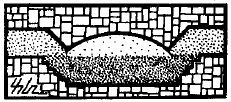
quote:
Confront the party with a lowered section of corridor filled with carbon dioxide. This will serve to put out the torches of passing parties, and will eventually kill any character foolish enough to stand around in the tunnel. (...) To make this trap even more deadly, you might experiment with placing a pocket of natural gas or hydrogen above the carbon dioxide in the lowered corridor. This could cause explosive consequences for those delvers who try to circumvent this trap by holding their torches above the CO 2 as they pass through the corridor.
Our first five-skull trap reviewed comes without illustration. Look Before you Leap by Mike Stackpole (yes, I presume that one) is the usual sort of "gotcha" the book is famous for.
quote:
Inform the delvers that they sense magic coming from the corridor ahead of them. A detection spell will reveal a pit beneath the floor, hidden from view by an illusion spell. The delvers, not wishing to be surprised by whatever lurks in the pit below, will probably cast some sort of magic to dispel the illusion. Lurking inside the pit is a gorgon...

Other traps in the section are designed to just mess with the party, splitting them up or redirecting them into different portions of the dungeon. The Chute and Hammer Trap , a three-skull trap by Jason Lujan, adds a bit of injury atop the insult.
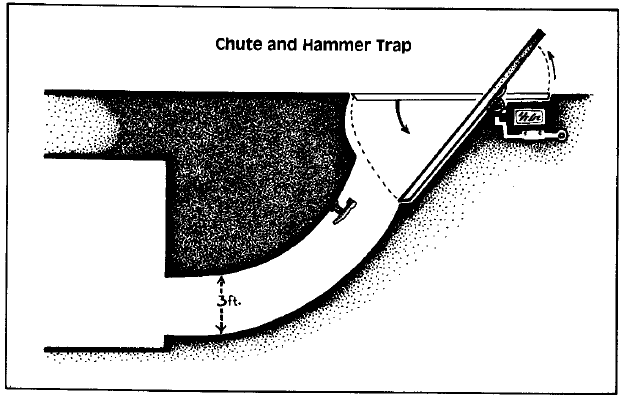
quote:
The trap activates when the party walks past the pivot point on a plate hidden in the floor. The plate will then tilt at a 45° angle, dumping almost anyone standing upon it into the aluminum chute below. The chute is very narrow; positioned within it is a hammer designed to strike characters in the forehead with considerable velocity as they slide by. The smaller kindreds might be able to avoid being bashed, but human-sized characters are in for a whopper of a headache.
To make this trap even more deadly than it already is, you could make the chute narrower - ensuring the characters will fall flat. Then, turn the hammer around so the claw end faces up the chute - this will catch the character under the jaw if he's sliding feet-first on his back, or at the base of his skull if he's skidding down on his face.

Our first one-skull trap of the review can't cause any harm at all, except perhaps to the gamemaster by the players. The Mapper Maddener by J. Walker is pretty much designed to be successful at its name...
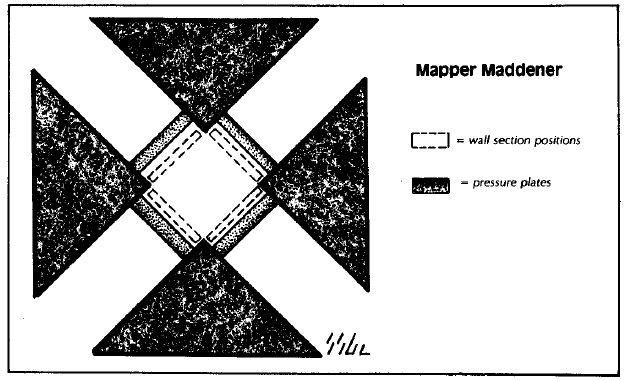
quote:
The trap is located in a corridor intersection, and is composed of a number of sliding wall sections. The sections are designed to rearrange themselves into various positions, altering the basic shape of the intersection into a "T", a straight section, or even a corridor or a dead end. Each time the characters pass by, the configuration will be different, playing hob with any maps the party may be making. Of course, the trap will only change the intersection when the delvers are out of seeing or hearing range, thus assuring their confusion.
As I mentioned above, traps involving pivot points are a common theme in the corridor trap section, and the three-skull See-Saw Corridor by John T.T. Longenbaugh is one example thereof. This illustration was even featured on the back cover!
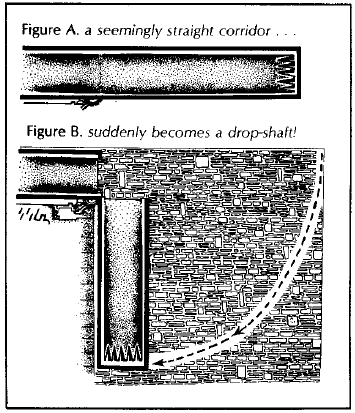
It makes sense; the actual writeup basically just describes the obvious that can be inferred from the picture, although it doesn't make any mention of hiding the far end of the corridor. In any case, the "compounded menace of a long fall and impalement will probably do most characters in."
Still, most of these have been fairly sane compared to the last section, right? Let's change that.
 A nice three-skull traps,
The Avenging Treadmill
by Uriah Ward, starts with a nicely ominous statement.
A nice three-skull traps,
The Avenging Treadmill
by Uriah Ward, starts with a nicely ominous statement.
quote:
To function properly this trap should be located in a cul de sac corridor where the room at the end contains something so horrible that the characters are likely to flee from it.
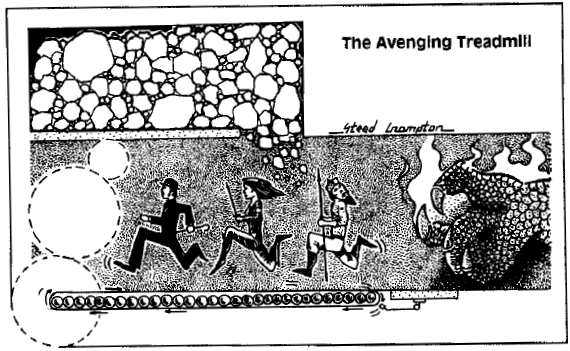
Have I mentioned I love some of these illustrations?

quote:
The corridor in question is, in reality, a treadmill device. The treadmill will not activated (begin to roll) until a character triggers it by opening the door at the end of the corridor. When the party opens the door and greets what horrible fate you have in store, they will almost certainly attempt to flee back down the corridor. When this happens, the effects of the treadmill will become apparent. The characters will be running in place, while the horror behind them gets closer and closer!
quote:
To make matters worse, running upon the treadmill activates a gear assembly, which will pull aside the ceiling above the characters. This should release upon the characters a torrent of something nasty: for instance, a load of boiling oil, or a small avalanche.

One last one for the road, before we move on. The Hero Sandwich by Mark O'Green and Edward Schoonover is a four skull trap, and...
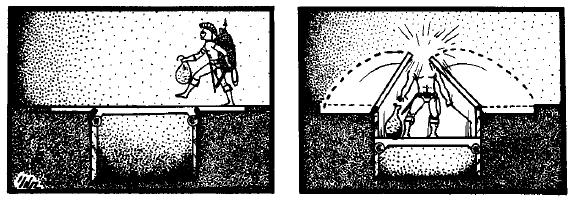
quote:
The trap is really a very simple one. Cover a shallow pit with a pressure plate. When a delver steps upon this plate, his weight will cause the plate to fall, bringing hinged sections of the same plate together in a slapping motion in the approximate region of the delver's head. Add a tomato, a pickle, and you're ready for lunch.
As mentioned though, this section is the largest in the book, and I've had to skip a whole lot. If anyone has a favorite I missed, lemme know and I'll give a write up! But the other obstructions were the Hop, Skip, and a Jump , the Sectioning Corridor , Archer's Tunnel , Mirror, Mirror, and the Fall , Magnificent Marble Misadventure , Trip Wire That Isn't , Last Laugh Trap , Between a Rock and a Hard Place , The Greystoke Memorial , Ball Bearing Corridor , The Slippery Pit . While the detours were, Which Way to the Front? , Orfiles Slide of Delver Dumping . The Murderers included, Pilum Pacifier , Folly Flight , Supercharger Crawlway , The B-B Slope , The Rolling Stone , CO2 Delver Extinguisher , Von Hindenburg Chamber , Air Thee Well . Aaand, the Step and Die traps, The Smashing Floor Trap , Whirling Blade Boot Bloodier , First Step Trap , Crossbow Thirteen , Stair Snare , The Piano Floor , The Flesh Pot .
... Okay. That's a lot. May as well take a few requests to elaborate on in a later post.
 Fortunately, tomorrow's section
Door Traps
is quite a bit shorter!
Fortunately, tomorrow's section
Door Traps
is quite a bit shorter!
Marbles & Memorials
Original SA postGlitterbomber posted:
Thanks to you I've bought the two Grimtooth's Traps books on DrivethruRPG (oddly, only the first and fourth?). Only a few of these will most likely see light of game, and those will be horribly ruined with such things like 'sporting chances' and shit, but they seem like a fun couple of books to have and just read.

Yeah, I'm not sure they're really "useful" books, especially in modern games, but it's fun still to see the collective malice of the roleplaying market condensed into simple, ironic death machines. In any case, going back to PurpleXVI's request... the Magnificent Marble Misadventure , a three-skull trap by David McConnell;
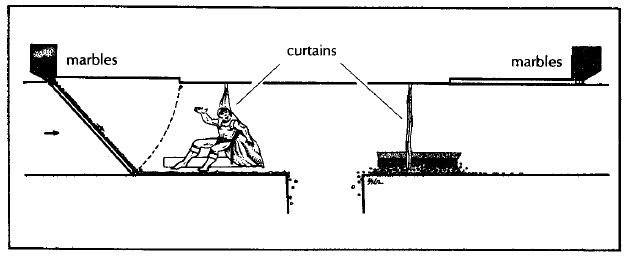
quote:
The trap is first encountered as a simple, unadorned set of curtains hanging across the dungeon corridor. When these curtains are disturbed or parted, a large door swings down from the ceiling behind the party, releasing a supply of oil-coated marbles onto the floor. The characters will probably have a hard time keeping their footing at this point, and might even end up falling into the pit on the opposite side of the curtain.
 Naturally, marbles are released on
both
sides of the pit, and the door behind them seals closed, so the writeup reminds of the great difficulty of safely jumping and landing on floors covered in grease and marbles. Not much traction! And best of all, the trap functions perfectly fine coming from either direction.
Naturally, marbles are released on
both
sides of the pit, and the door behind them seals closed, so the writeup reminds of the great difficulty of safely jumping and landing on floors covered in grease and marbles. Not much traction! And best of all, the trap functions perfectly fine coming from either direction.
The Greystoke Memorial , a three-skull by Brandon Corey, was one in the running for the last post. It's another one where the illustration really explains it all.
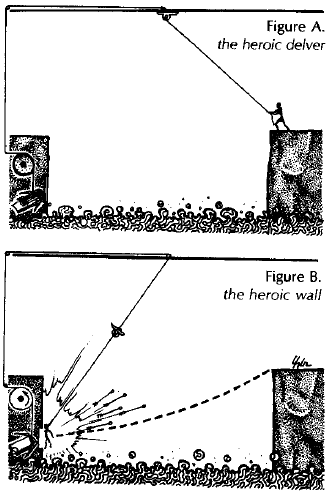
Heroes come across a pit filled with something suitably uncomfortable. Rope is conveniently placed to allow heroes to swing across the pit! Except it isn't actually attached to the ceiling like it looks, and readily lets them drop and fly into the far wall, presumably to tumble into the pit in a stupor afterwards. And okay, there is one thing that isn't immediately obvious from the pic...
quote:
To add insult to injury, Brandon has added a battery of crossbow bolts that fire along the delvers' projected angle of flight when tension is applied to the tackle device. Mindless overkill, true, but certainly more fun than watching yet another idiot delver act like Douglas Fairbanks.
 Sadly, this is another trap that requires a bit of GM-sadism blindness to function, but I'm sure proper pressure can be applied to encourage its use.
Sadly, this is another trap that requires a bit of GM-sadism blindness to function, but I'm sure proper pressure can be applied to encourage its use.
I already pointed out the Von Hindenburg Chamber, so let's move on to the Piano Floor . A four skull trap by Liz Danforth, and it really sounds a bit innocuous, maybe something focused on musi-
quote:
Place between the slats of a tile or wooden-slat floor a number of extremely sharp, long razors. Beneath each slat should be placed a spring that will depress when the corresponding floor section is stepped upon. The result is a painful one.
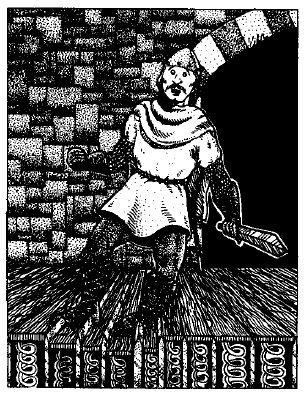


... A... anyway, The Flesh Pot , a two-skull trap from Pat Mueller, is simpler in comparison. It's "simply a pot of sticky glue" . That happens to dissolve flesh . It helpfully encourages the dungeon master to stick this beneath a false floor, in a hole where someone would reach, or any other place you'd want to deprive a delver of their extremity. I assume it's only two skull because it's only maiming, not fatal.
And hmm. Since the door trap section is fairly small, I'll just list them here; may as well do requests! They are: The Circular Doorway , Giant's Razor , The Guillotine Door Trap , Poison Door , Cure A Kicker Trap , Dry-Rot Door , Dragging Doorway , Double Door Doom , Delvermatic Dicer and Malingerer Trap .
Push to Enter
Original SA post Grimtooth's Traps - Push to EnterGrimtooth's Traps posted:
Doors are probably the most overlooked items in a dungeon, and with good reason. By and large, doors are usually transition devices between areas where the real action takes place: a warm-up act for the main attraction. As such, doors become commonplace objects, tackled with little caution and quickly forgotten. A few well-placed door traps will put and end to this.
Door traps are obviously fairly limited. There's a doorway, there's a trap there, adventurers get killed. Unsurprisingly this isn't the longest section, but as always there's plenty of brutality involved! Take for example The Circular Doorway , a four-skull trap by Pat Mueller.
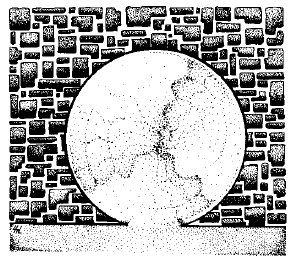
quote:
Present the delvers with a circular, doorless portal. The party will find that they can see a rather foggy image on the other side of the door (the room on the far side should be at least partially visible).
quote:
The fan blades are equipped with tiny barbs and jagged edges to ensure that most anything touching them will be drawn in.

Let's do a two for one next, since they're both in the same illustration. The four-skull The Guillotine Door Trap by James Brazier and Oliver Fittock, and the three-skull Poison Door by Rick Loomis.
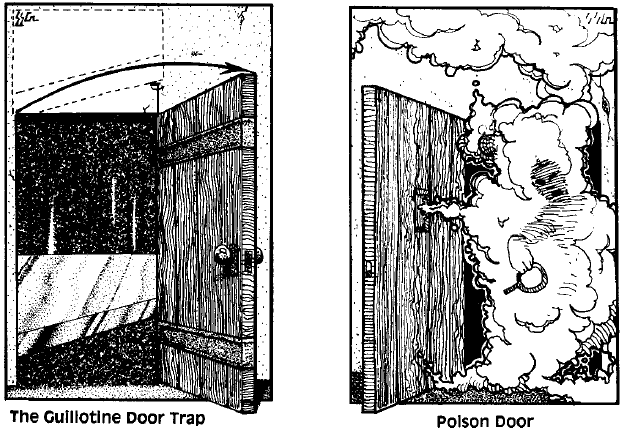
The Guillotine trap is fairly... self-explanatory, and the blurb relating to it is brief, noting that it triggers shortly after the door is opened. The Poison Door on the other hand...
quote:
Just because a door has a handle doesn't mean you have to use it - and if the delvers just push this door open, they'll live. Otherwise... The trap is a hollow door filled with poison gas. The door is equipped with a plug "handle" which, when pulled out, releases the gas.
 Yes, this series does seem to be designed around encouraging player paranoia, why do you ask? And if poison isn't good enough for you, it also suggests filling it with methane instead, so that it explodes thanks to the delver's torches once it's triggered...
Yes, this series does seem to be designed around encouraging player paranoia, why do you ask? And if poison isn't good enough for you, it also suggests filling it with methane instead, so that it explodes thanks to the delver's torches once it's triggered...
Coming up next, we have the Cure a Kicker Trap , a two-skull one by S.S. Crompton. Obviously, this is one of those ones designed to discourage the sort of paranoid behavior an adventurer might acquire, despite the other traps being what causes it in the first place...

quote:
The trap is triggered around a weighted wire located within the door. As long as the door is opened normally, no appreciable dislocation of the wire will occur, and the delvers can proceed safely. If, however, the door is broken (as by a kick), then the wire will be freed, loosing the gear structure above to propel a large, spear-like beam towards the character.

As this section isn't too long, let's finish off with the most... elaborate trap here, the four-skull Delvermatic Dicer and Malingerer Trap by Liz Danforth and Mike Stackpole (again). Just what does this entail? Well...
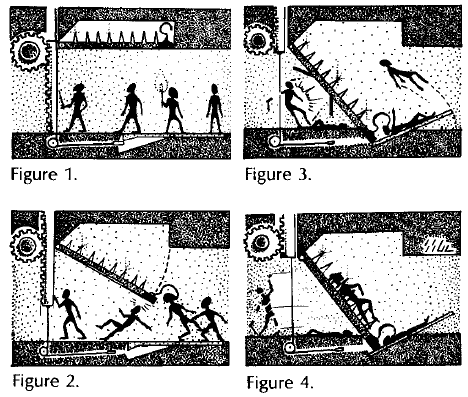
quote:
The secret door in question is set flush into the wall, and is designed to open by sliding into the ceiling. When the door is thus opened, delvers will see a net-like web of monofilament line on the other side.
 Well, this is off to a good start, isn't it? Nothing builds anticipation like being able to see where things are going.
Well, this is off to a good start, isn't it? Nothing builds anticipation like being able to see where things are going.
quote:
When the door slides up, it causes a section of the ceiling to swing down into the corridor. The section is such that it should slam into any character standing roughly six feet from the door. A devilish free-swinging hook trails the ceiling section, spelling doom for any delver standing about four feet from the fellow flattened by the ceiling section. (See Figure 2.)

quote:
The ceiling section completes its arc by slamming into the floor - which is in reality a carefully-balanced platform. This creates a catapult effect, and should send anyone standing as far away as twenty feet from the door flying into the spiked side of the ceiling section. (See Figure 3.)

quote:
The poor idiot who opened the door in the first place is in for the worst fate of all. Bay doors kick out from the falling ceiling section when it finally hits the floor, propelling the hapless door-opener through the fine monofilament mesh - with the appropriate "cheese-grater" effect. (See Figure 4).

... Well. In any case, tomorrow we'll be dealing with trapped Items and Artifacts !
 Since taking requests seems to work, let's give a list and see what people want to hear! This is another fairly large section and I may two it in two parts, and the options include:
The Hot Rocks
,
Nefarious Nymph Statuette
,
Magnesium Torch
,
Spy Glass
,
Moviola
,
Theft-Proof Gem
,
Jerk With the Box
,
Stuffed Raccoon
,
Rope Serpent
,
Speak Down
,
Lightning Gem
,
Idiot's Vase
,
Satan's Bow
,
Cup of Golden Mead
,
The War of the Ring Trap
,
Have A Ball
,
Vincent Van Gogh Seashell
,
Here Doggie!
,
A Cask of Immolation
,
Gauntlets of Doom
,
Turn-About is Fair Play
,
Well Blow Me Down!
,
Bury the Hatchet
,
Achilles' Shield
,
Cape of Dorian Grey
,
The Acid Test Scabbard
,
Iron Maiden Helmet
,
The Morningstar Supernova
,
Double-Crossbow
, and the
Atomic Necklace
.
Since taking requests seems to work, let's give a list and see what people want to hear! This is another fairly large section and I may two it in two parts, and the options include:
The Hot Rocks
,
Nefarious Nymph Statuette
,
Magnesium Torch
,
Spy Glass
,
Moviola
,
Theft-Proof Gem
,
Jerk With the Box
,
Stuffed Raccoon
,
Rope Serpent
,
Speak Down
,
Lightning Gem
,
Idiot's Vase
,
Satan's Bow
,
Cup of Golden Mead
,
The War of the Ring Trap
,
Have A Ball
,
Vincent Van Gogh Seashell
,
Here Doggie!
,
A Cask of Immolation
,
Gauntlets of Doom
,
Turn-About is Fair Play
,
Well Blow Me Down!
,
Bury the Hatchet
,
Achilles' Shield
,
Cape of Dorian Grey
,
The Acid Test Scabbard
,
Iron Maiden Helmet
,
The Morningstar Supernova
,
Double-Crossbow
, and the
Atomic Necklace
.

The problem with Looting
Original SA post Grimtooth's Traps - The problem with LootingGrimtooth's Traps posted:
Most traps offer some sort of "bait" to lure delvers to their doom - gold, jewels, devices of power, or some other tasty tidbit. After a steady fare of such "outwit the trap and get the treasure" situations, you'll probably find that the delvers in your dungeon respond to all your devices with Pavlovian predictability. This is where items and artifacts come in handy. The traps in this chapter take the "bait" concept to its logical conclusion - they case the bait itself to be the trap. No elaborate machinery or bottomless pits are used here; items and artifacts as traps substitute subtlety for overkill.
Take for example the four-skull Nefarious Nymph Statuette , by Mike Stackpole; yeah, he did a lot of these. What does this entail? Well...
quote:
Behind a waterfall of some sort stands a grotto or alcove, enchanted by latent magic to remain perpetually dry. Within the grotto sits a mound of treasure; resting atop the treasure is a beautiful statue of a water nymph. The statuette is made of a silvery white metal and stands about two feet tall. It is obviously of great value.
...
Have your guess yet?
...
quote:
The statuette was sculpted from pure sodium, an element that will combust upon contact with water.

Moving on, we encounter another five skull trap, a particularly devious one. The Spy Glass , also by Mike, is... well, read for yourself.

quote:
The device looks like an everyday hand-held telescope. It radiates some magic. A person who looks into it will see a blurred picture of an attractive member of the opposite sex. The act of focusing the "Spy Glass" moves a small ring inside that has been holding back a spring-loaded dagger. This dagger, a thin-edged blade, will enter the eye and perhaps the brain. Death (or at least blinding) is the result.
 Well, that was completely unnecessary, wasn't it? Er...
Well, that was completely unnecessary, wasn't it? Er...
Still, that was sane and plausible by Grimtooth standards, right? Let's try something a bit more silly. Another one by Mike Stackpole (and Liz Danforth!), the five-skull Moviola is an anachronism waiting to happen.
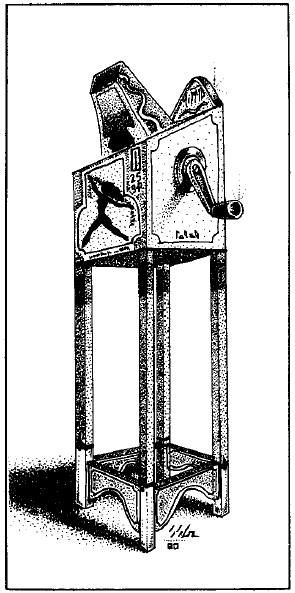
quote:
The "Moviola" is much akin to the little movie viewers common in numerous arcades. It will screen a film of a beautiful woman who removes veils in the fashion of a belly dancer. The film is in four sections, each revealing more than the last; each section will cost the viewer 25 gold pieces to watch. After 100 gold coins have been paid, the woman will remove the final veil - the one that covers her face and head. When the final veil falls, it will be revealed that the woman is a gorgon, and the viewer will be turned to stone.
 Okay, that definitely wasn't necessary. Seems like gorgon-related traps always involve a high rating, at least. And this one adds the further indignity of paying for the privilege!
Okay, that definitely wasn't necessary. Seems like gorgon-related traps always involve a high rating, at least. And this one adds the further indignity of paying for the privilege!
Moving on, let's skip down a bit to some less than lethal traps in comparison. Take for example the Jerk With the Box by Paul O'Connor, a one-skull item;
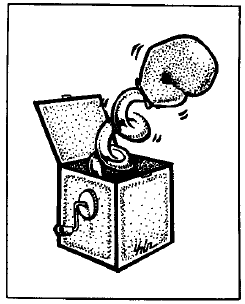
quote:
This item resembles an ordinary jack-in-the-box toy in all respects, and will resist all attempts at opening until the crank is turned. The box will play whatever tune you choose and then open - letting the spring-loaded boxing glove fly into the face of anyone dumb enough to hold to box.
quote:
For a stranger variation, load a cream pie within, instead.

Another mostly-harmless indignity is the one-skull Stuffed Raccoon by Stefan Jones.
quote:
This item - a stuffed and mounted raccoon that radiates intense magic and is indestructible by normal means - can be placed in most any convenient place around your dungeon. The enchantment on the raccoon is such that when it is placed within a closed container (such as a delver's sack of loot), it will wait for fifteen minutes and then return to the place it originally occupied - along with whatever items may have been with it in the sack at the time. The monsters of a dungeon usually catch on to this sort of thing rather quickly, and will probably haunt the area where the raccoon will return, eager to grab any treasure that might come back with it.
The last trap we'll be covering today is The War of the Ring Trap , a two-skull item from Liz Danforth.
quote:
The trap takes the form of an ornate pedestal, with the words "War of the Ring" inscribed upon it in several different languages. Atop the pedestal rests a beautiful unadorned gold ring. If a character is bold enough to take the ring, he learns that the ring is attached to the pedestal by a wire which allows the ring to be pulled away only so far before tugging back. The result is a somewhat comical tug-of-war, the results are subject to the particular characters involved in the battle. If the ring wins, well and good. It returns to its place on the pedestal.
...
Have your suspicion in mind now?
...
quote:
If the character wins, and sticks around to pat himself on the back, he'll find that the ring and wire constituted the pin assembly of a hand grenade located in the pedestal...

Anyway... next time, more item traps!
More Stuff!
Original SA post Grimtooth's Traps - More Stuff!Where we left off, we were discussing item traps. Some of them cursed, some of them mundane and deceptive in appearance, and all of them designed to destroy the party when the players attempt to strangle the dungeon master. Take, for example, the Speak Down trap. A one skull item by S.S. Crompton, so it has to be fairly benign, yet...
quote:
The trap takes the form of a bottle of blue liquid labeled "Blue Rose: Bottled by the Voiceless Ones" . No magic can be detected from either the bottle or its contents - in fact, the liquid smells like a fine wine. The liquid contains a mixture of rare and powerful chemicals known only as Kromptonite. This mixture, when imbibed, causes an instant paralysis of the vocal cords for a duration of not more than twelve hours. Any character drinking from the bottle will be struck dumb. The person playing the character is restricted to making gestures and writing notes - he may not speak again!
With a bit of luck and some crafty maneuvering, there's a good chance you could trick the party leader into drinking from the bottle. This will force the usually quiet characters to speak up, and might even lead to the doom of the "Big Mouth!"
 Which I guess brings up another way traps were used in the old days; passive-aggressively punishing people in the group! Oy.
Which I guess brings up another way traps were used in the old days; passive-aggressively punishing people in the group! Oy.
But moving away from that, we get to some more typical trapped items. Take for example the three-skull Satan's Bow , by Liz Danforth.
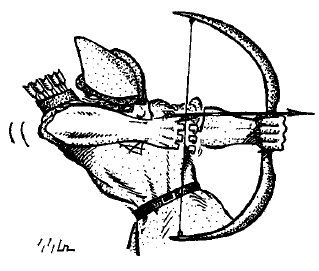
quote:
This metal bow is skillfully crafted and glows with a magical radiance. The light is really just a sucker's hook, designed to attract characters grabby for magical items. The bow is enchanted with a self-contained light spell to maintain this deception. The trap portion of the bow lies in the bowstring. The string is made of a very fine, diamond-dust studded wire. The bow itself, being made of metal, will not have the flex one would expect. The result - anyone trying to draw back the string of this bow will lose three fingers for the effort.
And you think I'm kidding? Well, let's take a look at the Vincent Van Gogh Seashell , a three-skull trap by Michael Austin.
quote:
The trap is magical, but is very simple in function, and takes the form of a beautiful seashell. The shell will seem to emit low whispers, inspiring a delver to pick it up and hold it to his or her ear. At this time, the magic of the shell activates - the delver's ear is teleported to a loved one. And every character has at least a mother.
 Why does this exist?
Why does this exist?
Well, not every trap is designed to maim the unwary. At least not directly! The two-skull Here, Doggie! , also by Austin, is short and simple.
quote:
In this case, the trap is easily recognizable as a simple dog whistle. The whistle will allow limited control of canines - but is also magically enchanted to attract wandering monsters...
Continuing with the idea of "unenchanted but trapped", there's the Gauntlets of Doom , a three-skull item also by Crompton.
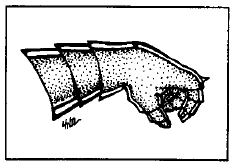
quote:
These gauntlets appear normal in every fashion, and will comfortably fit any normal-sized human. To make them more attractive to prospective delvers, you might wish to forge the gauntlets from silver. The problems with these gauntlets will become apparent the first time someone tries to punch something with them. The gauntlets are equipped with a thin bladder located between the lining of the glove and the external metal surface. Is something is struck with sufficient force the bladder will break, spilling its contents onto the hands of the wearer.
Naturally, the bladder holds a fatal contact poison.
Another one by Crompton is the two-skull Turn-About is Fair Play .
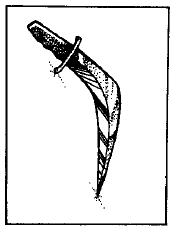
quote:
The trap is a finely-crafted curved throwing knife. It is well-balanced, and an obvious treasure for anyone interested in weaponry. However, the knife has been made so that it will boomerang when thrown. A character who hurls the knife at a foe has a fairly good chance of having it return at his face...
 This is another one I kind of like, since it's really simple and really obvious. Also perhaps something a skilled character could take advantage of... if they survive the first use anyway. It's kind of a winner all around.
This is another one I kind of like, since it's really simple and really obvious. Also perhaps something a skilled character could take advantage of... if they survive the first use anyway. It's kind of a winner all around.
As you can see, most of these item traps are of only moderate lethality, and the last two I'll cover today keep up the idea, both being three-skull rated. The first is The Morningstar Supernova by Ashley Morton.
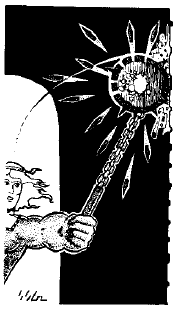
quote:
This morningstar is built around a solid, explosive core; when a solid object is struck, the morningstar points will fire out in all directions with enough force to make a hand grenade look like a cream pie by comparison.
 I like this one a little less than the last, since it's not... quite as obvious. But it sure seems effective.
I like this one a little less than the last, since it's not... quite as obvious. But it sure seems effective.
And last but not least, we have the Atomic Necklace , also by Morton.
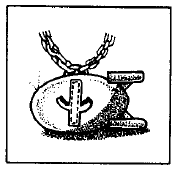
quote:
The necklace chain is made of finely wrought gold - beautiful enough to ensure that greedy dungeon delvers will want to make it their own. Attached to the chain is an inch-long charm shaped very much like a bomb. The necklace is designed such that if it is ripped from the body of a monster, the chain will tear apart at the bomb, pulling its pin and causing a detonation...
 And if you were expecting a
radioactive
necklace, I think that one's in the second book...
And if you were expecting a
radioactive
necklace, I think that one's in the second book...
And that brings us to the end of the Item Traps! Coming up next, we'll deal with Things , which are the miscellany of stuff that doesn't quite fit into the other categories, be it furniture, living creatures, and so on. And after that comes the mysterious 101st trap... but that can wait a little while. This is another shortish section, and the available options include the Sword Breaker , Eye-Catching Trap , Wall Wards , Fountain Trap , Floor Creature , Going Down? , Ariadne's Revenge , Four on the Floor , Various Killers of Paranoids , A Hot Time in the Old Camp Tonight , and The Cranequin Goose . Have a favorite trap, or curious about one? Lemme know!

Leftovers
Original SA post Grimtooth's Traps - LeftoversGrimtooth's Traps posted:
What are "things", you ask? "Things" are things, I reply. Things are peep-holes drilled into dungeon walls. Things are floors that aren't, and eye-catches that are. Things guard chests, masquerade as fountains, lie snug within dungeon walls, and hide gleaming below dungeons floors. Things aren't just any old thing. Discover them at your own risk.
 There's a little bit of overlap with other sections, such as the Room and Corridor traps, but in general stuff found here is found in or a part of a normal dungeon environment, rather than an integral component thereof.
There's a little bit of overlap with other sections, such as the Room and Corridor traps, but in general stuff found here is found in or a part of a normal dungeon environment, rather than an integral component thereof.
The lethality is highly variable here, as well. For example, we'll start off with Johnny Green's one-skull Sword Breaker .
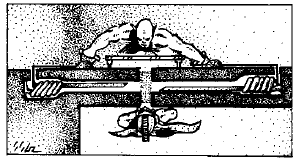
quote:
A one-way mirror has been installed behind the standard hole-in-the-wall. Behind this mirror stands a bloodthirsty and fearsome troll, his hands held ready upon twin daggers. Poised within the wall, set so as to spring powerfully into the middle of the hole, sit two sharpened iron wedges. When a delver looks through the hole, he sees the reflection of his own eyes looking back at him. The troll beyond the glass cannot be seen, due to the nature of the mirror - but the monster can certainly see the delver (and he'll probably drool with anticipation). Seeing "eyes" staring back at him, the delver will probably quickly move for his sword, then stab it deep into the hole in an effort to blind the creature beyond. When this happens, the troll releases the wedges, and crack! - the sword is broken.
quote:
If the delver uses his daggers instead, note that his elbow will probably pass into the wall at the point where the steel wedges usually meet. More's the pity.
The next trap is somewhat similar in idea to the sword breaker, and the book even points out this fact. The Eye-Catching Trap (another from Mike Stackpole) is however rated four skulls. Why? Well...
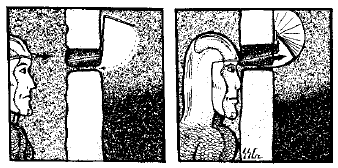
quote:
Set in a wall, perhaps partly hidden by intricate stonework, are two eye-holes. If a delver peers through them, he will see what lies in the room beyond. Fill the room with something that will interest the adventurer - anything from enemies to treasure to dancing girls should do the trick.
 That said...
That said...
quote:
Inform the character that he can see a little of the room, but if he moved closer to the holes he could probably get a better view. After all, trying to peer through a small set of holes from a distance is something like looking through a telescope held some distance from the eye. If the character moves in closer to get a better look, the pressure of his forehead against the stone wall will cause a section of the wall to move slightly, dislodging the spike on the other side of the hole to swing freely. The whole assembly will swing down into the eyes of the delver, with predictable results.
 That was... that wasn't necessary you know. I mean- wait, there's more?
That was... that wasn't necessary you know. I mean- wait, there's more?
quote:
For added cruelty, the pokers can be made of barbed wood that will easily break loose when the character jerks his head away from the hole in pain.
 This is only four skulls because it's not instantly fatal...
This is only four skulls because it's not instantly fatal...
Let's... go a little simpler. The Floor Creature by Paul O'Connor is a three-skull rating, and obviously a bit more of a monster than a trap...

quote:
The creature lies on or slightly above standard dungeon floors. The creature's natural coloration closely mimics the appearance of common stone. In short, the floor should appear normal, save for a slightly "spongy" or "springy" feel. When a creature feels pressure upon its hide, it will rapidly constrict into a ball. Characters standing on the creature have various chances of jumping free, depending on how close to the edge of the room they stood. The "Venus Floor Trap" kills by constriction - again, it will probably take an entire group of characters to kill it, while those trapped inside can do nothing but scream.
Moving on, we come to Four on the Floor by Brandon Corey. A three skull rating, and both curiously niche and devious.
quote:
This trap will work anywhere you can put a table. Upon the table are located four glasses, each containing an opaque liquid of a different color as well as a precious gem or stone. Each glass is set on the table rim-down, so that the liquid within cannot leak from the class. The liquids are the trap. As a glass is broken or lifted from the table, the fluid within will spill out upon the table. The fluids, when intermixed, will cause a chemical reaction - one that produces a poisonous gas as a byproduct.
Coming up next isn't so much a single trap, as a variety of traps under a single theme. Various Killers of Paranoids , collectively a three skull trap assortment by Scott Rhoads, is focused on the idea of how to punish those players who have functioning pattern matching skills after dealing with this DM for a while.
quote:
Ever get tired of watching characters open chests and such from a distance with a pole, thus avoiding all your careful traps directed at anyone trying to loot the treasure within? With each of these traps, the character who opened the chest is safe, but a person standing a respectable distance away is in trouble - and someone standing out of the room entirely is subject to an even worse fate.
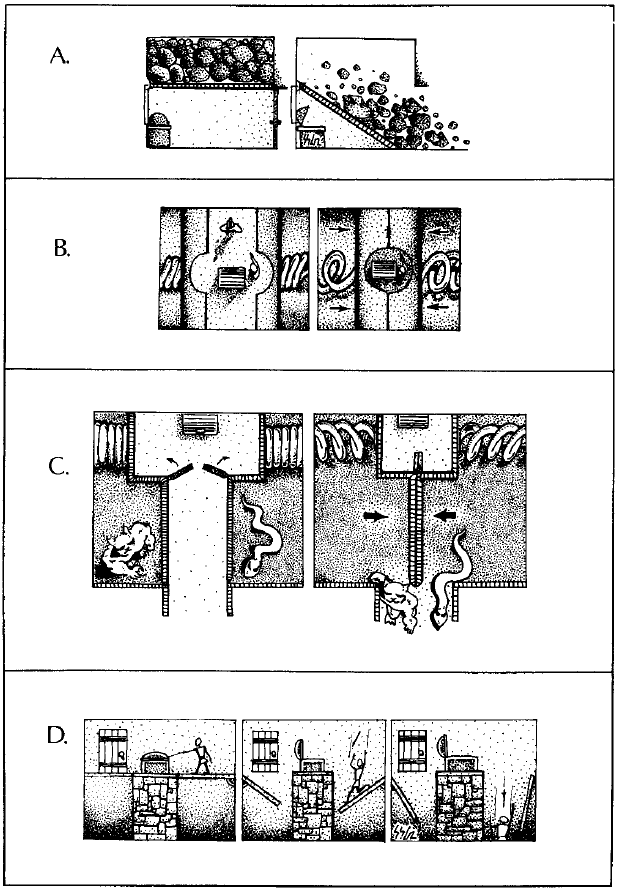
All entirely self-explanatory at a glance, as the book goes on to note.
 Death by irony is always amusing, isn't it? Although I guess these only get three skulls because the person who activated them gets away... hmm.
Death by irony is always amusing, isn't it? Although I guess these only get three skulls because the person who activated them gets away... hmm.
Also, I thank all of you who asked for The Cranequin Goose , because this is one I would have included at all costs regardless. Also by Mike Stackpole, that despicable bastard, and earning every last goddamn one of its four skulls.
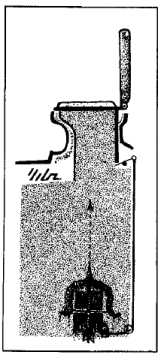
quote:
In a public facility without internal plumbing - such as an outhouse or an open-pit toilet - a character will find a finely appointed stall. If this is set in a King's chambers, you might wish to pad the seat. In any event, if a character should decide to make use of the facility, he or she is in for an unpleasant surprise. Any pressure upon the seat activates a crossbow located in the cesspit below. The resultant "goosing" effect can range from being comical to fatal, depending on your mood. A fine way for a high and mighty hero to die, don't you think?

 I guess the only reason it's four skulls instead of five is, really, when was the last time adventurers ever encountered a lavatory while dungeon delving?
I guess the only reason it's four skulls instead of five is, really, when was the last time adventurers ever encountered a lavatory while dungeon delving?
And that brings us to the end of the section, and nearly to the end of the book. That was a pretty good and memorable one to leave off on, wasn't it? There's not much left, and unless someone has a particular favorite I missed along the way, only one trap remains... tune in tomorrow, for...
 The 101st Trap!!!
The 101st Trap!!!

The Finale
Original SA post Grimtooth's Traps - The FinaleAnd we're already to the end! As mentioned at the start, Grimtooth's Traps is not a very long book; sure, there's 101 traps in here, but they're often two or three to a page. And of course, there's several sequels... at least seven books in the line I believe, eight if you include the d20 compilation? But we're not quite done yet here. There's still one more trap, the ultimate, the 101st . There's no skull rating for this one, and it should be readily obvious why once you've read it. And unlike the other traps, which I've tried to summarize and annotate rather than just copy directly, this one only really works if you have the full page in your hands.
Are you ready? There's no turning back now.
This is your last chance.
Don't say I didn't warn you.
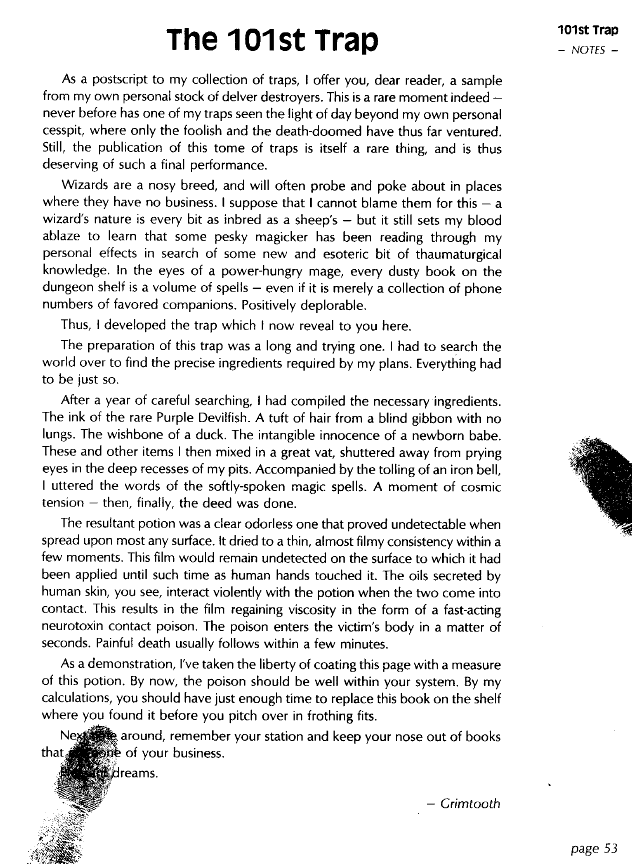
... Oh, Grimtooth.

And now that we've seen the breadth of the book, I... still like it? At the very least, it's an interesting footnote in the development of the hobby. Roleplaying games were, when the book was originally printed, less than a decade old - D&D itself came out only seven years prior! And even then the stereotypes of capricious dungeon masters and greedy short-sighted player characters were already fairly solidified, to the point that you could do parodies that still hold up over thirty years later.
And while it's never really stated, you're not intended to actually use everything in the book, or even much of it. It's idea fodder to be repurposed into your own (hopefully less lethal) traps, or to be sprinkled out with great care in order to keep the players cautiously optimistic. It's also why I probably won't be covering the sequels, although I sure won't stop anyone else from doing so; once you understand the mindset behind it, it's surprisingly easy to come up with new traps along the same lines. This is probably why they managed to make another half-dozen books out of reader submissions over the following decades!
But for those at home who aren't using a touchscreen, thanks for joining me on this nostalgic trip back in time.
